Porcelain Insulator News
by Elton Gish
Reprinted from "Crown Jewels of the Wire", December 2003, page 6
There seems to be an ever-growing interest in porcelain insulators at shows.
More dealers have porcelain on their tables and a wide variety is showing up on
Ebay, too. It is great for those of us who look for something different. You may
think that all possible markings on unipart porcelain insulators have been
reported. I used to think that, but new markings have popped up in the last
couple of years. Maybe the added interest in porcelain has people looking closer
at their collection. In this issue of PIN we will show you the ones I have
recorded over the past year or so.
I do not remember who reported the first
marking, which was found on a U-447. It is actually an error marking. Note the L
in LOCKE is upside-down. The "2" is the catalog number and the
"V" indicates the insulator was made at the Victor, NY plant. Those
made at the Baltimore, MD plant will not have a letter code in this type of
marking.

Locke marking error on a U-447.
Dwayne Anthony reported the next marking on a U-3 and a U-65. The incuse marking
shown in the photo was deeply struck on the top of the insulator. The
two large dots may be rivets that held the LOCKE marking on the hand stamp.
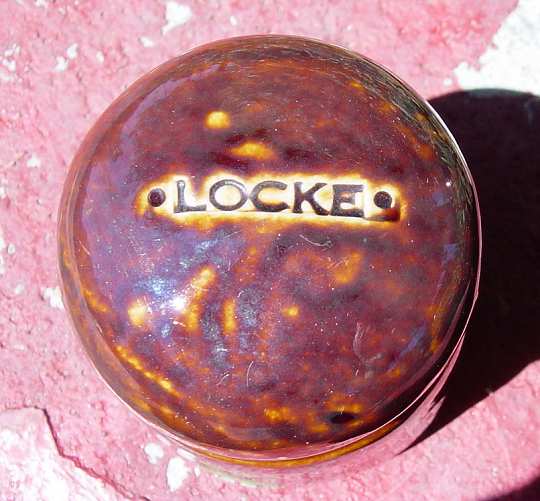
Unusual incuse Locke marking found on U-3 and U-65.
Robin Harrison reported a U-202A made by Pittsburg with an incuse
"356" on the top. In case someone is wondering if it could be the
catalog number, this style was cataloged as No. 18. Note the very light colored
mold line over the top, which shows up quite will against the blackish brown
glaze.
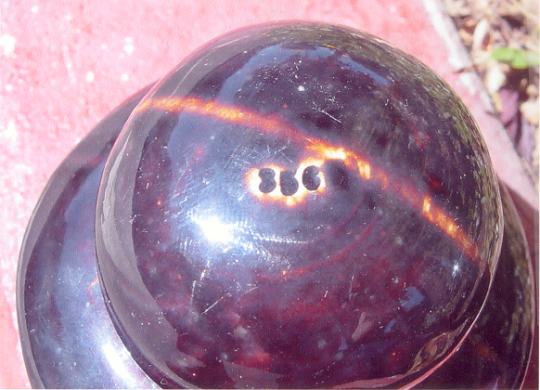
A Pittsburg made U-202A with incuse "356" on the top.
Cooper Power Systems bought out the McGraw-Edison factory in Macomb, IL in 1985. They continued to make porcelain insulators until the late 1990's. The
insulators were marked with blue under-glaze ink markings.
One example was
found on the new style, U-880A (see Supplement 2001), which had a blue-gray
"sky-tone" glaze and radio treated top with the following U-G ink marking:
M94
E 2
56-1
The "M" and "E" represented McGraw-Edison with the year
1994 and the "2" indicating the second quarter of 1994. The
"56-1" was the ANSI Class number. Later Cooper changed to a
"CPS" marking dropping the use of the ME. I saw a U-735 on Ebay with
the following blue under-glaze ink marking:
CPS 5
99335
55-4
The "CPS" naturally represented Cooper Power Systems and the
"55-4" was the ANSI Class number. I assume the "99" in the
number represented the year 1999, but the number could have been the catalog
number.
Two other markings on sky-tone glazed insulators with black radio treated
tops were reported about two years ago. I'm sorry that I did not record the name
of the person who reported them. The first marking is on an insulator similar to
U-653:
L63 R
JOSLYN 86
The "86" is the year of manufacture. Joslyn insulators were made by
Pinco in Lima, NY, which stopped making pin-types in 1987. The next double
marking has been reported on several styles: U-425B, U-488, U-490, U-649, U-666,
U-735, and U-737. The U-666 reported had this combination marking that includes
the year of manufacture:

Jeff Hogan reported the next marking on a U-310. The black underglaze ink
marking is on the skirt. It is like marking No.5 in the Jack Tod book, Porcelain
Insulator Guide Book, except it also has the number "23" vertically
inside an oval on the right. This is the year of manufacture, 1923. I checked
Jack's file on Lapp and found a copy of a Lapp engineering drawing showing
several marking designs. There were two sizes of markings like the one on Jeff's
insulator. One of them is shown below:

The U-310 (in photo) has unusual under-glaze ink marking..
Note catalog
number "591" and year "23".
It is odd that the catalog number shown on Jeff's insulator was
"591". U-310 was Lapp's catalog number "591A". The
"591" style was shown in the 1918 catalog, but not in later catalogs.
It was probably replaced by "591A". The closest style to
"591" in the U-Chart is U-309, but no one has reported a Lapp in that
style.

Jeff also reported an insulator with a very large incuse Lapp
marking. The usual size incuse marking is 1/4" wide x 1/2" tall. The
larger marking is 1/2" wide x 3/4" tall. Has anyone seen a Lapp
marking this large?

Glen McAdam reported an interesting marking on the mine insulator U-94. It
has the usual white glaze and embossed marking, THE. O.B. CO. MANSFIELD, O.,
around the pinhole. Glen noticed a recess-embossed Square D marking on the
opposite end of the insulator next to the pinhole. Square D purchased the Peru
plant in 1920 (operated as the Moulded Insulator Division), which made dry
process insulators. The Square D trademark was registered in 1922 indicating use
since 1914. Square D may have contracted with Peru to make insulators for them
from 1914-1920 and as business grew decided to purchase the plant, which was
expanded in 1927. (line drawing below)

Glen also reported a U-680A with a large incuse E" on the skirt. There
are two sizes of "E" marking found on multipart insulators made by
Thomas. Perhaps Glen's U-680A was also made by Thomas. Tom & Mary Miller
reported getting one from Lu Farin's collection.
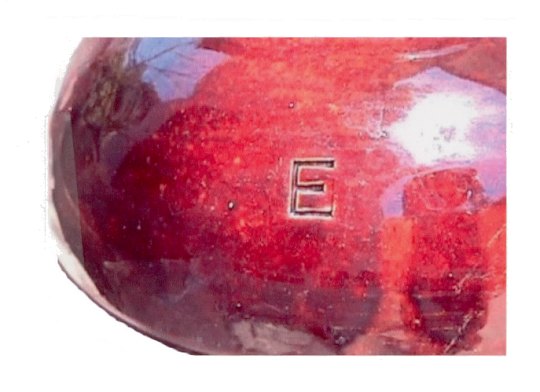
U-680A with large incuse "E" on the skirt.
Clint Gaylord reported a variation of the incuse Illinois marking that
includes the year of manufacture. He has a white U-267 with the following incuse
marking on the skirt:
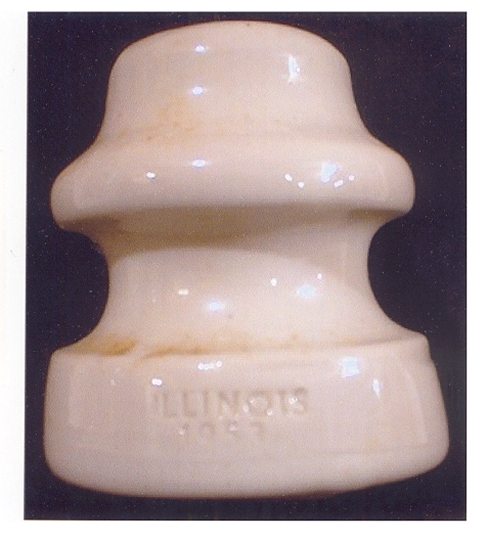
ILLINOIS
1953
Shaun Kotlarsky reported an unusual Ohio Brass marking on
a U-368. The glaze is an early mottled gray color. Usually these have an
embossed O-B on the edge of the crown. This typical O-B marking is engraved in
the mold so every insulator is marked. It is the only embossed marking found on
wet process porcelain insulators. However, Shaun's U-368 does not have this
embossed marking. Instead, there is a deeply struck recess-embossed O-B marking
on the skirt! We can only assume that this insulator was made just prior to the
crown marking being cut into the mold. I would guess Shaun's insulator was made
around 1907-1908. Ohio Brass bought out the Akron HP factory in 1907 and soon
began using the crown marking. This specimen of U-368 was probably made shortly
after the purchase of the factory. (Pics below)

U-368 with unusual recess-embossed DB marking on the skirt.
There is one last marking to report. It is a bit ho-hum for interest, but we
may as well mention it for completeness. The Gould logo marking has always been
an incuse marking. That seems like a rather odd marking method for a modern line of insulators made from 1977-1981. The more typical marking method would
be under-glaze ink. Perhaps started near the end of their production, Gould did
indeed use an under-glaze ink logo marking.
The u-g ink marking has been reported on U-832 and U-880A. (below)
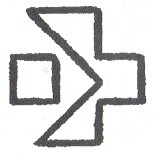
I'll bet not many of you have seen the large incuse P.R.R. marking, which is
rarely seen on U-179. I haven't seen one in many years and surely don't remember
seeing one this clear. You can see from the photograph that the marking nearly
covered the top of the insulator.

U-179 with large incuse P.R.R. marking
| 